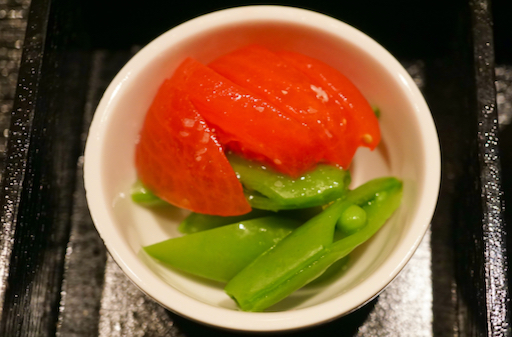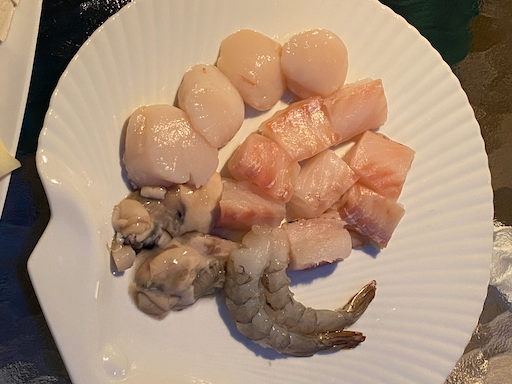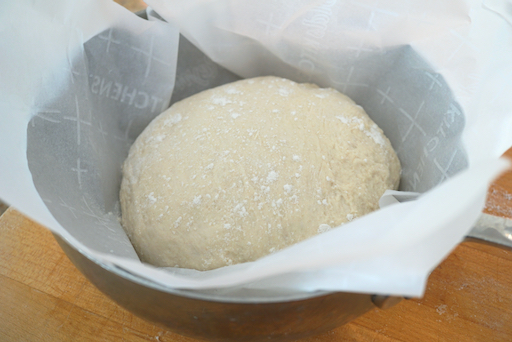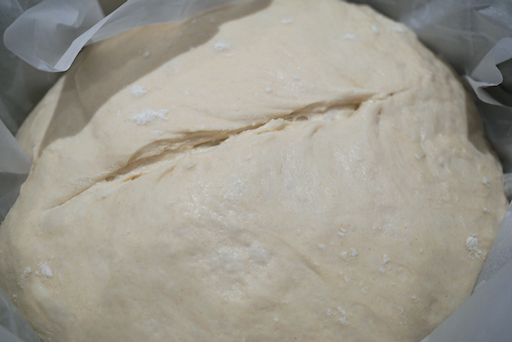Saturday, February 27, 2021
One spoonful appetizers and more
Wednesday, February 24, 2021
Seafood nabe on a snowy day 雪降りの夕の海鮮鍋
Sunday, February 21, 2021
"Almost" no-knead bread, improved version of no-knead bread ほとんど捏ねないパン改善版
Ingredients: (I am listing the original Kenji's recipe and metric weight in parenthesis which I converted by weighing the ingredients but not just numerical conversion of "cups" and "tsp", "tbs").
3 cup (425g) AP flour (Instead of bread flour, this recipe uses AP flour, I am not sure why but I should try it with bread flour).
3/4 cup plus 2 tbs (207g) water
6 tbs (80g) beer*
1 tbs (13g) white distilled vinegar (I used rice vinegar)
(Total liquid of 290g which makes hydration rate of 68%)
1 1/2 tsp salt
1/4 tsp instant yeast
*Kenji recommends to use light Pilsner-style lager beer such as Budweiser. I did not have Bud in our fridge so I used Sam Adams' Boston lager.<
Directions:
In a bowl, mix the ingredients using a wood spoon until no dry flour remains.
Take the dough out and put on a floured board and knead 10-15 times. Make into a boule-shaped dough ball.
Place the dough in a parchment paper lined skillet (below picture. Kenji's recipe include spraying with vegetable spray but I do not see the need for that and skipped that process).
Place this uncovered in the proofing box (the box has a water tray providing moisture to prevent a skin from forming on the dough). Let it rise for the second time for 1-2 hours.
Bake for 30 minutes with the lid on and 5-10 minutes more minutes with lid off.
Thursday, February 18, 2021
Milk bread with condensed milk and tangzong コンデンスミルクと湯種のパン
for the tangzong
20 g (2 Tbs. + 1 tsp.) AP flour
for the dough
115 g (1/2 cup) whole milk
12 g (1 Tbs. sugar)
5 g (1 1/2 tsp yeast)
320 g (2 2/3 cups AP flour)
3 g (1 tsp. salt)
60 g (3 Tbs.) sweetened condensed milk (I have used up to 90g of condensed milk which worked just fine.)
1 large egg
55 g (4 Tbs. butter, melted)
egg wash (optional)
1 large egg
1 Tbs. whole milk
Directions:
for the Tangzhong: whisk the flour and milk together in a sauce pan. Heat until it thickens. Set aside and let cool.
for the dough: Warm the milk and add the sugar. Cool to 110 F and use it to bloom the yeast. In a stand mixer combine the flour and salt. Add the condensed milk, egg, melter butter, tangzhong and yeast mixture. Mix until a dough forms. Knead for 7 to 10 minutes. Shape to dough into a ball. Add to a bowl and coat with a thin coating of oil. Put bowl in a warm place (we used the proofing box) until doubled in size. Punch dough down. Shape into a loaf and put into a greased bread loaf pan. Back into the proofing box until doubled in size. If using the egg wash, mix the egg and the milk then brush over the loaf. Cook in a preheated 350 degree oven for 28 to 30 minutes until it is golden brown and sounds hollow when tapped. Let cool on a wire rack.
The main difference between this bread and previous versions was the texture. It was still very light but there appeared to be a lot more holes. It was still very soft and moist. It almost melted on the tongue. It also didn’t rise as much as the previous versions. It had a buttery slightly sweet flavor. This was still a wonderful bread lightly toasted and buttered.
Monday, February 15, 2021
One spoonful appetizers a.k.a baby food for adults 一口スプーンの前菜第二弾
Ingredients:
Broccoli stem, hard bottom removed and hard skin removed (I used stems of two broccoli heads), cut into small cubes.
One medium onion, finely diced
One parsnip (or maybe a potato), skinned, cut into small cubes.
1/2 cup of chicken broth or more depending on the consistency of the puree (I used Swanson's no fat reduced salt)
1 tsp unsalted butter and 2 tbs olive oil
Salt to taste
Two bay leaves (optional)
Directions:
Add the olive oil and butter to the pan on medium flame and sauté the onion until cooked (2-3 minutes).
Add the broccoli stem and parsnip and coat with butter/oil and add the chicken both to cover.
Remove the bay leaves and puree using an immersion blender until smooth (add more chicken broth for desired consistency).
Season with salt
These appetizers are nice. The spoonful is just the right amount for a satisfying gulp. They provide a nice range of flavors although the consistency seems, well consistent. It is lovely and smooth but I can’t help but think of it as sophisticated “baby food for adults”. I’ll have to come up with something different.
Friday, February 12, 2021
Perfectly pillowy cinnamon rolls 完璧に柔らかなシナモンロール
This recipe is from King-Arthur flour. The recipe was on a card that was enclosed with the collapsible bread proofing box we recently bought from them. This recipe piqued my wife's interest because it is made with "tangzhong" 湯種 and, of course, because it is a "sweet" bread. So she made this one day. She also added raisins but omitted the icing called for in the original recipe.
Ingredients:
for the Tangzhong
1/2 cup (113 g ) whole milk
3 Tbs. (23 g) bread flour
2/3 cup (151 g) cold whole milk
2 1/2 cups (300 g) bread flour
1 tsp. salt
2 Tbs. (25 g) sugar
2 tsp. yeast
4 Tbs. (57 g) butter softened
1 cup raisins or nuts (optional)
for the filling
1 Tbs. (14 g) butter, melted
1/2 cup (107 g) light brown sugar, packed (amount reduced slightly or increased to taste)
2 Tbs. (15 g) bread flour
4 tsp. (10 g) cinnamon
pinch of salt
For the icing (optional) I did not use it.
3 Tbs. (42 g) butter melted, divided
1/2 tsp. vanilla
1 1/2 cup (170 g) confectioners sugar, sifted
1 to 2 Tbs. (14 g to 28 g) milk
Directions:
For the tangxhong: in a small saucepan, whisk together the milk and flour and cook over medium heat until thickened. Transfer to a large bowl.
For the dough: Immediately add the dough ingredients to the bowl with the tangzhong in the order listed. (The order is important because the cold milk cools the tangzhong to the right temperature for the yeast). Mix and knead to make a smooth, elastic, somewhat tacky dough. Knead for 7 - 10 minutes. Put in a bowl and move to the proofing box set to 81 degrees until the dough rises and is puffy.
To assemble: Transfer the dough to a lightly greased work surface and pat into a 10 X 12 inch rectangle. Stir together the filling ingredients and sprinkle over the dough, leaving a 1/2 inch strip uncovered on one of the long sides. Distribute the raisins or nuts over the filling. Starting with the filling covered long side, roll the dough into a log. Slice into 12 slices. Put the pieces on a parchment lined baking sheet spaced about 2 inches apart. Tuck the tails underneath each roll to keep them from unravelling as they rise. Back into the warmer until they about double.
Bake on a rack in the upper third of a preheated 375 degree oven for 14 to 18 minutes until light golden brown. Remove from the oven and brush with 1 1/2 Tbs. of melted butter.
For the Icing (optional): Mix the remaining 1 1/2 Tbs. (21 g) melted butter with the remaining icing ingredients. Ice the rolls while they are just lukewarm.
These rolls have just the right amount of sweetness and the butter cinnamon mixture is very nice. While they were baking and when they were lightly microwaved before serving the yeasty cinnamon aroma was one of the pleasures of these rolls.
Tuesday, February 9, 2021
Pork curry with almond sauce アーモンドソースポークカレー
We like to roast pork in our Weber but because of Covid, the cuts we usually use for roasting are not always available and we have had to make do with whatever we can get. Case-in-point, we recently got a bone-in shoulder pork roast. This cut was very large. In addition, it contained a portion of the scapula bone which I removed requiring some further “at home” butchery to get the various sizes and portions that we wanted. In this case I removed the bone and divided the roast into three segments. The first segment was the meat around where the bone was removed. I cut it into small chunks for stew or curry. The remaining two segments consisted of a smaller portion of roast which I used for “ni-buta” 煮豚 or simmered pork and a larger portion of roast which I barbecued in our Weber.
I commissioned my wife to come up with a dish using the small chunks and suggested a curry. This time, my wife wanted to make a new curry she had not tried before. She chose one from Madhur Jaffrey’s cookbook “Indian Cooking. In addition to using quite a few spices (#1 & #2 below), it also includes pulverized almonds which is something we have not used before. The resulting curry is shown in the picture below. It was a lunch one day. I served the curry over rice with tomato (Skinned Campari tomato), blanched sugar snaps and broccoli which I warmed up in the curry while the curry was being heated.
Ingredients:
2 garlic cloves
1 inch sized ginger cube coarsely chopped
5 Tbs. slivered almonds, roasted
3/4 to 1 cup of chicken stock
2 lbs. of pork shoulder cubes
1/2 tsp. cardamom
1 tsp. cinnamon
1/4 tsp. cloves
1/4 tsp. cayenne pepper
1 1/4 tsp. salt
1/4 tsp. garam masala
Directions:
Add several tablespoons of peanut oil into wide frying pan. Add the cardamom, cinnamon and cloves and cook until they “bloom” becoming fragrant. Put in the onions and cook until lightly browned (#4). Put in the almond paste as well as the coriander, cumin and cayenne pepper (#5). Stir until it browns slightly. Add the meat the salt as well the chicken stock (#6). Cover and cook on simmer for several hours until the meat gets tender. Add the garam masala before serving.
Just a Note: The meat did not get tender in the sauce even after several hours so I removed it and put it in a sauce pan covering it with chicken stock. I simmered it that way for about an hour. It got nicely tender and made additional sauce in the chicken stock. I added the meat back and sauce into the curry and it was much better.
Saturday, February 6, 2021
"Kuri-mu pan" Cream custard buns クリームパン
Ingredients:
for the custard:
2 large eggs + 1 egg yolk
70 g sugar (1/3 cup)
15 g corns starch (2 Tbs.)
20 g cake flour (2 Tbs.)
300 g milk (1 1/4 cup)
1 tsp. vanilla
1 Tbs. butter
for the dough
250 g bread flour (2 cups)
50 g cake flour (1/3 cup)
30 g sugar (2 Tbs.)
20 g sweetened condensed milk (1 Tbs +1 tsp)
80 g cream (1/3 cup)
80 g milk (1/3 cup)
1 tsp. yeast
1/2 tsp. salt
30 g cold butter cut into small cubes (2 Tbs.)
Directions:
For the custard
In a bowl, mix eggs, sugar, corn starch and cake flour until well combined. Heat milk in a sauce pan until steaming. Temper the egg mixture with the hot milk by adding several ladles full slowly and stirring to combine. After the egg mixture is tempered add it to the milk still in the sauce pan. Cook on medium low heat until it starts to thicken, stirring constantly. This could take some time so be patient. When it achieves a fairly firm consistency (i.e. won't run off if placed on a flat piece of dough). Take it off the heat. Add the butter until melted and then stir in the vanilla. Continue whisking so it doesn't form a skin as it cools. After it cools slightly cover with plastic wrap touching the top of the custard, again so it doesn't form a skin as it cools. Set aside or put into the refrigerator to use later.
For the dough
Add everything from the bread flour to the yeast into a stand mixer. Mix until dough forms. Let it rest for 30 minutes. Add the salt and knead for 1 minute. Add the butter a piece at a time kneading the dough until smooth. Knead 7 to 10 minutes. Form into a ball in a greased bowl. Turn the ball until it is covered with grease. Put into proofing box set at 81 degrees. Let it rise until doubled in size.
To assemble:
Punch down dough. Weigh the dough and calculate how many 50 g buns the dough will make. Then weigh the custard and see how much each scoop of filling must weigh to equally fill the 50 g buns calculated. I completely encased the filling for 8 buns in dough and put them on a parchment lined cookie sheet. I formed the remaining buns into balls and put them on the cookie sheet. The cookie sheets went back into the proofing box until the buns had about doubled in size. I took the buns made into balls but not filled with custard and using the base of a small cup dipped in flour pressed down on the center of the ball until the cup stopped moving. I then filled the depression with the remaining calculated portions of custard. I took the remaining egg and glazed the fully encased muffins completely and the depression filled buns just on the bread portion. I cooked them in a 375 degree oven for 12 to 18 minutes or until golden brown. I removed them from the oven and cooled on a rack.
These buns were everything you would expect in a kashi pan. The dough was tender and slightly sweet. The custard was luscious, not too sweet and vanilla flavored. What a breakfast treat!
Wednesday, February 3, 2021
Sweet condensed milk bread
Ingredients
1 cup milk
2 1/4 yeast (just a note: this is the amount of yeast usually used to make 2 loaves. This may have been another reason the bread rose so much so quickly.)
1 1/2 tsp. salt
1 Tbs. butter
3 1/4 cups bread flour
2/3 cup sweetened condensed milk
1 egg lightly beaten
Directions
Proof the yeast in the slightly warmed milk with the sugar dissolved. Add the yeast mixture and every thing except the egg to the bowel of a stand mixer. Mix until a dough forms. Knead for 7 to 10 minutes then turn out onto a lightly floured board and form into a ball. Place dough in a greased bowel turning to grease all over. Place in the proofing box set for 81 degree temperature until double in size. Punch down and form a loaf and put into a greased loaf pan. Put into the proofing box again until the loaf doubles in size. Brush the surface with the egg and bake in a 350 degree oven for 30 to 35 minutes until golden brown and sounds hollow when tapped. Turn out onto a wire rack to cool.
This is a very lovely bread. Nice soft texture and a complex flavor just slightly sweet. The flavor was even better the next day. The texture was a bit denser and moist compared to the previous Japanese milk bread we made. Nonetheless it is a wonderful toasted/buttered breakfast bread.



































